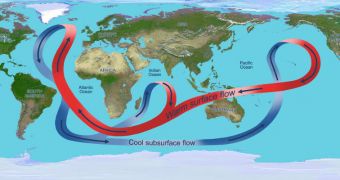Using their advanced Earth-sensing capabilities, experts at NASA determined that the Atlantic Meridional Overturning Circulation, which is a part of the oceanic conveyor belt, had not slowed down over the past 15 years. The investigators say that the formation, which plays an instrumental part in regulating the temperatures and climates that areas around the North Atlantic (Europe and North America) are subjected to, may have even accelerated slightly. In charge of the investigation was Josh Willis, an oceanographer at the NASA Jet Propulsion Laboratory (JPL), in Pasadena, California.
The research was only made possible due to a new scientific observations technique that Willis pioneered. The method combines datasets collected by NASA satellite altimeters with information gathered by the 3,000 floats that make up the Argo profiling array. This is an automated network of floats that roams the world's oceans, collecting data about their salinity, temperature and velocity. The data collected from altimeters show variations in the height of the world's water. By combining the two, the JPL expert developed a potent new tool for keeping track of changes in the ocean.
In a paper appearing in the March 25 issue of the esteemed scientific publication Geophysical Research Letters, the investigators show that their datasets cover a region stretching approximately between New York, on the eastern coast of the United State, and northern Portugal. This area of the Atlantic, situated at about 41 degrees latitude, houses the northward-flowing section of the Meridional Overturning Circulation, and is therefore critically important for any studies of this sort. Without its warming effect, Europe, northern Africa and northern America would most likely experience much cooler weather, or even be covered in a large ice sheet.
“The changes we're seeing in overturning strength are probably part of a natural cycle. The slight increase in overturning since 1993 coincides with a decades-long natural pattern of Atlantic heating and cooling. No one is predicting another ice age as a result of changes in the Atlantic overturning. Even if the overturning was the Godzilla of climate 12,000 years ago, the climate was much colder then. Models of today's warmer conditions suggest that a slowdown would have a much smaller impact now,” Willis says.
“But the Atlantic overturning circulation is still an important player in today's climate. Some have suggested cyclic changes in the overturning may be warming and cooling the whole North Atlantic over the course of several decades and affecting rainfall patterns across the United States and Africa, and even the number of hurricanes in the Atlantic,” he concludes.

 14 DAY TRIAL //
14 DAY TRIAL //